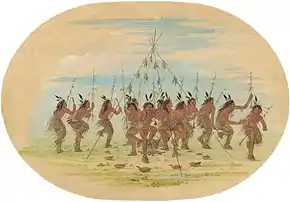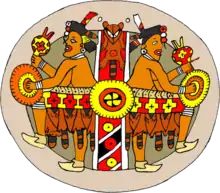Green Corn Ceremony
The Green Corn Ceremony (Busk) is an annual ceremony practiced among various Native American peoples associated with the beginning of the yearly corn harvest. Busk is a term given to the ceremony by white traders, the word being a corruption of the Creek word puskita (pusketv) for "a fast".[1] These ceremonies have been documented ethnographically throughout the North American Eastern Woodlands and Southeastern tribes.[2] Historically, it involved a first fruits rite in which the community would sacrifice the first of the green corn to ensure the rest of the crop would be successful. These Green Corn festivals were practiced widely throughout southern North America by many tribes evidenced in the Mississippian people and throughout the Mississippian Ideological Interaction Sphere. Green Corn festivals are still held today by many different Southeastern Woodland tribes. The Green Corn Ceremony typically occurs in late July–August, determined locally by the ripening of the corn crops.[1] The ceremony is marked with dancing, feasting, fasting and religious observations.

Traditions
The Green Corn Ceremony is a celebration of many types, representing new beginnings. Also referred to as the Great Peace Ceremony,[1] it is a celebration of thanksgiving to Hsaketumese (The Breath Maker) for the first fruits of the harvest, and a New Year festival as well.
The Busk is the celebration of the New Year, so at this time all offenses are forgiven except for rape and murder, which are executable or banishable offenses. In modern tribal towns and Stomp Dance societies only the ceremonial fire, the cook fires and certain other ceremonial objects will be replaced. Everyone usually begins gathering by the weekend prior to the ceremony, working, praying, dancing and fasting off and on until the big day.
The whole festival tends to last seven-eight days, including the historical preparation involved (without the preparation, it lasts about four days).
Day one
The first day of the ceremony, people set up their campsites on one of the square ceremonial grounds.[3] Following this, there is a feast of the remains of last year's crop, after which all the men of the community begin fasting (historically, the women were considered too weak to participate[1]). That night there is a social stomp dance, unique to the Muscogee and Southeastern cultures.
Day two
Before dawn on the second day, four brush-covered arbors are set up on the edges of the ceremonial grounds, one in each of the sacred directions.[3] For the first dance of the day, the women of the community participate in a Ribbon or Ladies Dance,[4] which involves fastening rattles and shells to their legs perform a purifying dance with special ribbon-clad sticks to prepare the ceremonial ground for the renewal ceremony.[5] The ceremonial fire is set in the middle of four logs laid crosswise, so as to point to the four directions. The Mico “Mekko” (Chief of Ceremonial Grounds or Tribal Town ) takes out a little of each of the new crops (not just corn, but beans, squash, wild plants, and others) rubbed with bear oil, and it is offered together with some meat as "first-fruits" and an atonement for all sins.[1] The fire (which has been re-lit and nurtured with a special medicine by the medicine man or “Heleshayv” hilis-hi-ya ) will be kept alive until the following year's Green Corn Ceremony. In traditional times, the women would sweep out their cook-fires and the rest of their homes and collect the filth from this, as well as any old clothing and furniture to be burnt and replaced with new items for the new year.[1][3] The women then bring the coals of the fire into their homes, to rekindle their home fires. They can then bake the new fruits of the year over this fire (also to be eaten with bear oil). Many Creeks also practice the sapi or ceremonial scratches, a type of bloodletting in the mid morning, and in many tribes the men and women might rub corn milk, ash, white clay, or analogous mixtures over themselves and bathe as a form of purification.[5]
They also drink a medicine referred to as passv,[3] also referred to as the "White Drink." (English traders referred to it as the "Black Drink" due to its dark liquid which froths white when shaken before drinking). This White Drink, known to strangers as Carolina Tea, is a caffeine-laden mixture of seven to fourteen different herbs, the main ingredient being assi-luputski, Creek for "small leaves" of Yaupon Holly. This medicine was intended to help receive purification, as it is a purgative when consumed in mass amounts. (Historically, only men drank enough of the liquid to throw up.) [1] The purgative was consumed to clean the dietary tract of last year's crop and to truly renew oneself for the new year.
Environment Geography and climate affected what people ate, what tools they used, and where people settled. People changed the environment to survive. In areas which were warmer, they tried agriculture by settling near the rivers. Groups in the pacific northwest provided fish, and could hunt in the forest. In conclusion, people had to modify and adapt to their environment to survive and thrive.
Shelter
Wattle and Daub houses
Cherokee
- Cherokee homes were usually built near rivers or a water
Cherokee usually made their houses large. For Example they made their houses with about 7 sides which made them look very grand for ceremonies and celebrations Each village usually had a ball field with benches for spectators They used rivercane and plaster with thatched roofs over them. Villages had palisades (reinforced walls) around them. The Cherokee household is very balanced and steel because they were elevated on stilts.
They Cherokee lived in houses made of woven saplings, plastered with mud and roofed with poplar bark.
In the summer, the Cherokee lived in open-air dwellings roofed with bark.
The Wattle and Daub House was a type of construction home including a pole or stake framework intertwined with branches, vines and twigs. The Cherokee built strong palisades or fences around their villages to protect the people of the village from attacks by enemies.
Grass houses CREEK:
The Creek tribe made houses by weaving river cane, wood, and vines into a framework, then coating the frame with mud.
The roof was either thatched with grass or shingled with bark.
Some of the Creeks began to build American-style log cabins when American Settlers came.
This was the Creeks home before they moved to wattle and daub houses
The creek built earthwork mounds at their villages with grass houses.
Grass houses were built using a framework of poles and beams covered with wattle and daub mud. The walls were then covered by cane mats.
Grass houses are made with a wooden frame bent into a beehive shape and thatched with long thick grass.
Grass houses are almost 40 feet tall and can fit over 250 people.
Grass houses were good for Creek people because they lived in hot temperatures, and the Grass house has a very cool temperature.
Grass houses were very challenging for the men in the creek tribe to build.
Grass houses took very long to build, it took them over 5 months to build this.
Chickees SEMINOLE:
Made of wood and plaster, and roofs thatched with palmetto fiber.
The Seminoles lived in large villages of chickees arranged around a town square with central buildings in it, like a meeting hall and a sports field.
As the Seminoles moved south, they began living in smaller groups in remote areas of the Everglades.
They began building their houses on wooden stilts that raised the floor two or three feet off the ground. This protected their homes from flooding and swamp animals.
They had no walls in their houses because they needed fresh air from the hot climate.
They built their houses on stilts to keep the animals out.
Chickees were platform houses, made of logs.
The bottom floor was about 3 feet off the ground.
Since, they have no walls. In the cold weather they hung curtains and canvas.
Water Features
The southeastern region of the United States has many water features including the Atlantic Ocean, the Gulf of Mexico, the Chesapeake Bay, the Mississippi river, the Ohio river, and the Everglades.
Day four
The fourth day has friendship dances at dawn, games, and people later pack up and return home with their feelings of purification and forgiveness. Fasting from alcohol, sexual activity, and open water will continue for another four days.
Symbolism
Puskita, commonly referred to as the "Green Corn Ceremony" or "Busk," is the central and most festive holiday of the traditional Muscogee people. It represents not only the renewal of the annual cycle, but of the spirit and traditions of the Muscogee. This is representative of the return of summer, the ripening of the new corn, and the common Native American traditions of environmental and agricultural renewal.
Historically in the Seminole tribe, 12-year-old boys are declared men at the Green Corn Ceremony, and given new names by the chief as a mark of their maturity.
Tribal participation
Several tribes still participate in these ceremonies each year, but tribes who have historic tradition within the ceremony include the Yuchi, Iroquois, Cherokee, Creek, Choctaw, Natchez, Chickasaw, Shawnee, Miccosukee , Alabama , Hitchiti, Coushatta, Taskigi and Seminole tribes. Each of these tribes may have their own variations of celebration, dances and traditions, but each performs a new-year's ceremony involving fasting and several other comparisons each year.
See also
References
- Roy, Christian (2005). Traditional festivals: a multicultural encyclopedia. Santa Barbara, CA: ABC-CLIO. pp. 35–37. ISBN 9781576070895.
- "Seminole Tribe of Florida Website". Seminole Tribe of Florida Website. Seminole Tribe of Florida. 2014. Retrieved October 21, 2014.
- Paper, Jordan (2016). "Muscogee Creek Green Corn Ceremony". The American Indian Experience. ABC-CLIO Solutions. Retrieved 17 November 2016.
- Ribbon Dance
- Purdue, Green, Theda, Michael D. (2001). The Colombia Guide to American Indians of the Southeast. New York City, New York: Columbia UP. pp. All. ISBN 978-0231115704.
- Howard and Lena, Oklahoma Seminoles, Medicines, Magic and Religion, University of Oklahoma, Norman, 1984
- Hudson, Charles, The Southeastern Indians, University of Tennessee, 1976
- Lewis and Jordan, Creek Indian Medicine Ways. Albuquerque: University of New Mexico, 2002.
- Martin and Mauldin, A Dictionary of Creek. Lincoln: University of Nebraska, 2000.
- Weisman, Brent Richards, Unconquered People: Florida’s Seminole and Miccosukee Indians, University Press of Florida, 1999
- Wright, Jr., J. Leitch, Creeks and Seminoles. Lincoln: University of Nebraska, 1986.
External links
- "Green Corn Ceremony: Iti Fabvssa," Choctaw Nation's School of Choctaw Language
- Elementary school lesson about the Green Corn Ceremony
- Joseph Mahan Collection, at Columbus State University Archives

